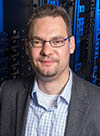 Oliver “Oli” Gutsche
Oliver “Oli” Gutsche
Senior Scientist
U.S. CMS Software & Computing Operations Program Manager
Telephone: (630) 840-8909 E-mail: gutsche@fnal.gov Office Location: WH11SE
Areas of Focus: Software & Computing, BSM, Program planning/management
Biography
My current physics interests are focusing on proton-proton physics at the Large Hadron Collider (LHC) at CERN, Geneva, Switzerland. I am a member of the Compact Muon Solenoid (CMS) collaboration that built and operates one of the four detectors recording the world’s highest energy proton-proton collisions. I am interested in Beyond-Standard-Model (BSM) physics searches, especially in the area of dark matter. I find the techniques centered around long lived particles very intriguing, as they go beyond the default particle reconstruction that assumes that particles originate close to the primary collision point in the detector.
Since March 2019, I am the U.S. CMS Software and Computing Operations Program manager. My duties include enabling U.S. CMS physicists in their analysis activities by providing computing facilities at Fermilab and U.S universities. The operations program also provides software for the CMS collaboration from the core software framework to execute the many simulation and reconstruction algorithms, to computing infrastructure software like data management and workflow management software.
In the longer term, I am planning to invest into Machine Learning techniques both for my analysis projects and to answer questions for the computing infrastructure. Machine Learning is very intriguing to me, but needs to be treated carefully. One of the aspects that we need to understand is uncertainties related to using Machine Learning techniques. Paired with new techniques that allow for analysis of exabyte size datasets, my longer term goal is to enable a successful physics harvest in the HL-LHC era.
Selected recent publications:
J. Albrecht et al., **A Roadmap for HEP Software and Computing R&D for the 2020s**, *Comput. Softw. Big Sci.* 3 (2019) 7, doi:[10.1007/s41781-018-0018-8](https://doi.org/10.1007/s41781-018-0018-8), arXiv:[1712.06982 \[physics.comp-ph\]](http://arxiv.org/abs/1712.06982)
M. Cremonesi et al., **Using Big Data Technologies for HEP Analysis**, *EPJ Web Conf.* 214 (2019) 06030, doi:[10.1051/epjconf/201921406030] https://doi.org/10.1051/epjconf/201921406030), arXiv:[1901.07143 \[cs.DC\]](http://arxiv.org/abs/1901.07143)
L. Bauerdick et al., **HEP Software Foundation Community White Paper Working Group – Data Analysis and Interpretation**, (2018), arXiv:[1804.03983
\[physics.comp-ph\]](http://arxiv.org/abs/1804.03983)
V. Khachatryan et al., **Measurements of $t \bar t$ charge asymmetry using dilepton final states in pp collisions at $\sqrt s=8$ TeV**, *Phys. Lett.* B760 (2016) 365–386, doi:[10.1016/j.physletb.2016.07.006](https://doi.org/10.1016/j.physletb.2016.07.006), arXiv:[1603.06221 \[hep-ex\]] http://arxiv.org/abs/1603.06221)
Personal website:http://home.fnal.gov/~gutsche
